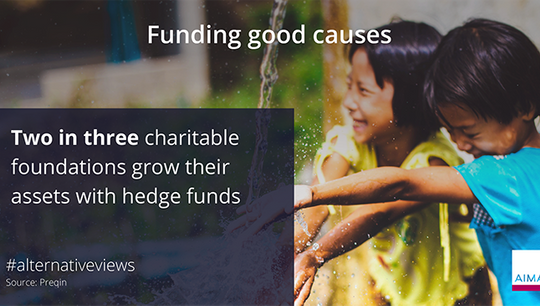Contributing to Communities: A global review of charitable and philanthropic activities by the hedge fund industry
By AIMA
Published: 01 May 2013
The following is an online summary of this particular AIMA paper
Foreword
I am delighted to introduce Contributing to Communities, the first review of its kind of the charitable and philanthropic activities of the hedge fund industry worldwide.
The report has been produced by the Alternative Investment Management Association (AIMA), the global hedge fund industry association. One of our objectives traditionally has been to draw attention to the value the hedge fund industry brings to society as a whole, from the role that hedge funds play in stabilising financial markets to the benefits of capital preservation and diversification that they offer to their investors, the majority of whom today comprise sociallyimportant institutions such as pension funds, endowments and, indeed, charitable foundations.
The industry has always engaged in charitable giving and philanthropy. In this report, we have focused just on those activities that are in the public domain (much charitable activity being private). We have chosen to eschew images of gala dinners, celebrity endorsements and presentation cheques so often associated with the industry’s charitable activities.
Instead, our primary focus has been on where the money raised ultimately goes — whether a school in a deprived part of London, a much-loved public park in America, a facility in Britain for developing the next generation of scientists or a hospital for sick children in Asia, to name but a few.
We have not sought to judge whether the volume and scope of the industry’s charitable and philanthropic activities are sufficient, or whether or not they compare well with other industries. We should not forget that the hedge fund industry is itself a fairly small community. We have estimated that around 100,000 people are employed directly by managers in the industry worldwide, which, if it were a single company, would still fail to make Fortune’s list of the 50 biggest corporations in terms of employees. Suffice to say, and given its size, the hedge fund industry does — and quite rightly — make a real contribution to communities.
We also recognise the limitations of charity and philanthropy itself. Altruistic gestures are features of compassionate societies. But they should not be a substitute for addressing the deeper causes of poverty and inequality. The charitable and philanthropic activities of the hedge fund industry matter, but they can only ever achieve so much.
Andrew Baker
CEO
AIMA
Executive summary
Charitable and philanthropic activity in the global hedge fund industry is widespread. Hedge fund managers and staff are engaged with charities in a multitude of different ways.
These activities range from workplace giving programmes to personal foundations set up by a manager or group of managers to donate a portion of their wealth, to board membership or trusteeship of established charities.
Some of the largest individual contributions include George Soros’ Open Society Foundation, which directed $742 million towards charitable causes in 2010, the most recent available data[1] ; Paul Tudor Jones’ Robin Hood Foundation, which receives donations from across the industry as well as public fundraising drives and which gave $146 million in grants to dozens of poverty-fighting programmes in New York City in 2012[2] ; Louis Bacon, the founder of Moore Capital Management, who has spent close to $400 million on 202,000 acres of land in the US that are either already in conservation easements or soon will be[3] ; and the Simons Foundation, which gave $122 million in 2011, also the most recently available data[4] .
Hedge fund industry figures who have dedicated the majority of their wealth to philanthropy by signing the Giving Pledge, an initiative launched in 2010 by Warren Buffett and Bill and Melinda Gates, include Bill Ackman, John Arnold, Ray Dalio, Christopher Hohn, Julian Robertson, Jim Simons and Tom Steyer[5] .
But in terms of the charitable and philanthropic activities of the industry, even these examples may be only the tip of the iceberg. The report focuses only on activities in the public domain. It is worth noting that very often the industry’s charitable and philanthropic activities are done in private, and without publicity. The report also sets out the benefits accrued by the third sector and society more generally as a result of these activities.
Also outlined are some of the operational issues and challenges faced by hedge fund managers and staff in setting up charitable initiatives. Deciding on a funding model, selecting and monitoring beneficiaries, and marrying work and charitable commitments are some of the common issues raised by interviewees in reflecting on their experiences.
Above all, the report seeks to highlight the social benefits of the global hedge fund industry’s charitable and philanthropic activities: from tangible gains such as the funding of new schools, medical equipment and housing to more intangible benefits including improvements to charities’ strategic planning and financial operations.
The report’s findings are based on interviews with individuals from the hedge fund industry who are active in the charity sector and representatives of charities, which were carried out during 2012 and 2013. Those responses are used in tandem with publicly available data on the financial and social activities of hedge fund charities to gain a detailed picture of global hedge fund charitable activity.
[1] Open Society Foundations, 2012. ‘Expenditures’. Available at www.opensocietyfoundations.org/about/expenditures
[2] The Robin Hood Foundation, 2011. ‘Financials’. Available at www.robinhood.org/about/financials
[3] Forbes magazine, January 2013. Available at www.forbes.com/sites/erincarlyle/2013/03/28/audubon-society-gala-honors-louis-bacon-bette-midler-sings-birdie-tunes
[4] The Simons Foundation, 2011. ‘Annual report’. Available at http://simonsfoundation.s3.amazonaws.com/share/2011_Annual_Report.pdf
[5] The Giving Pledge, 2013. Available at http://givingpledge.org/index.html









